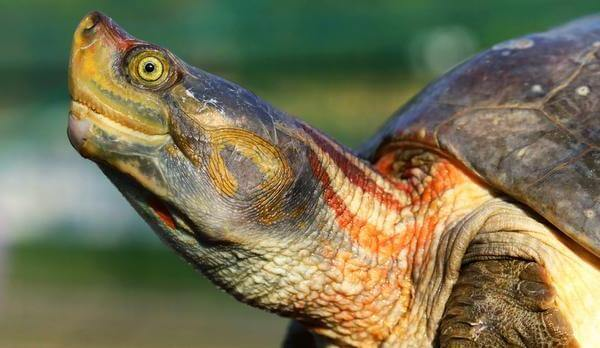
09-Jun-2025 11:00 AM
In a major step toward the conservation of critically endangered species, 20 Red-Crowned Roofed Turtles (Batagur kachuga) were successfully reintroduced into the Ganga River after a gap of 30 years. This historic event took place under the Namami Gange Mission, a project aimed at cleaning and rejuvenating the Ganga River while also focusing on the preservation of biodiversity. The reintroduction of this species marks a significant achievement for wildlife conservation efforts in India.
The Red-Crowned Roofed Turtle, scientifically known as Batagur kachuga, is a freshwater species native to the Indian subcontinent. It is found in countries such as India, Nepal, and Bangladesh. Historically, these turtles inhabited the Ganga and Brahmaputra Rivers, but in recent years, their viable habitat has shrunk, with the Chambal River becoming one of the few remaining locations where they can still be found.
The Red-Crowned Roofed Turtle is listed as Critically Endangered by the International Union for Conservation of Nature (IUCN). In India, it is protected under Schedule I of the Indian Wildlife Protection Act, which offers the highest level of protection for endangered species. Internationally, the species is listed under Appendix I of CITES, prohibiting any international trade in the turtles or their parts.
Female Red-Crowned Roofed Turtles are considerably larger than their male counterparts. They can grow up to 56 cm (approximately 2 feet) in length and weigh around 25 kg (55 lbs). In contrast, males are smaller, often about half the size of females, and consequently, much lighter.
The turtle’s shell is hard and ridged, which provides protection and helps it swim in strong currents. Juvenile turtles possess angled undersides (plastrons) that offer additional defense mechanisms. The Red-Crowned Roofed Turtle has a short, slightly pointed snout, which allows it to breathe while staying submerged for long periods.
During the breeding season, male Red-Crowned Roofed Turtles develop striking bright red, yellow, and blue streaks on their necks. These colorful markings are used to attract females, serving as a key feature during mating rituals.
These turtles are primarily found in deep, fast-flowing rivers where they thrive. They prefer habitats that include sandy beaches or sandbars, which are essential for laying their eggs. The turtles’ reliance on these specific types of habitats makes them particularly vulnerable to habitat loss.
Red-Crowned Roofed Turtles are strict herbivores, feeding predominantly on aquatic plants and algae. Their diet is vital to their health, and the availability of these food sources directly impacts their survival in the wild.
Breeding takes place from March to April when the temperatures are warm. Females lay between 11 to 30 eggs per clutch, which hatch after about 60 to 70 days. Females dig nests in sandy banks or beaches to deposit their eggs, ensuring they have a safe and secure environment for hatching.
The primary threats to the Red-Crowned Roofed Turtle come from the destruction of their natural habitats. Pollution, dam constructions, and excessive water use in rivers have severely impacted their living conditions. Additionally, the loss of sandy beaches due to human interference reduces available nesting sites.
Sand mining and agricultural activities along riverbanks also pose significant threats to the turtles. These activities damage or destroy nesting sites, leaving the turtles with fewer options for laying their eggs.
Despite being protected by law, Red-Crowned Roofed Turtles are often poached for their meat, which is considered a delicacy, and their shells, which are used to make ornaments. Illegal hunting and trade continue to be significant threats to the species.
What is the primary food source for the Red-Crowned Roofed Turtle?
A) Fish and insects
B) Aquatic plants and algae
C) Small crustaceans
D) Insects and amphibians
Answer: B) Aquatic plants and algae
What is the conservation status of the Red-Crowned Roofed Turtle?
A) Vulnerable
B) Endangered
C) Critically Endangered
D) Least Concern
Answer: C) Critically Endangered
Where do the Red-Crowned Roofed Turtles primarily lay their eggs?
A) On riverbanks with rocky surfaces
B) In tree branches near the river
C) On sandy beaches or sandbars
D) On floating vegetation
Answer: C) On sandy beaches or sandbars
What unique feature does the male Red-Crowned Roofed Turtle develop during the breeding season?
A) A larger shell
B) Bright red, yellow, and blue streaks on its neck
C) A longer snout
D) Larger claws
Answer: B) Bright red, yellow, and blue streaks on its neck
Which of the following is a significant threat to the survival of Red-Crowned Roofed Turtles?
A) Excessive rainfall
B) Sand mining and farming on riverbanks
C) Overfishing in their habitat
D) High altitude winds
Answer: B) Sand mining and farming on riverbanks